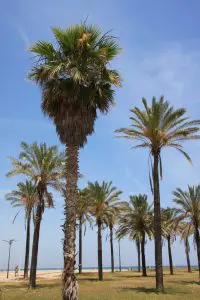Book your football excursion to Valencia CF easily in just four simple clicks
Book and customise your complete football excursion to Valencia CF in the simplest way possible. Choose which match, hotel & seat you require clearly in one location. There are no booking fees.
Book a complete football trip to Valencia CF and enjoy the legendary Estadio Mestalla while you are still able to. Valencia CF is the third most popular club in Spain after Real Madrid and FC Barcelona. It is not easy to get match day tickets with over 50,000 season ticket holders and 20,000 people on the waiting list. FootballBreak will be able to guarantee you seats next to one another.
Its steep, vertigo like stands, means the Estadio Mestalla is one of the most intimidating stadiums in Europe. You are seated close to the pitch and can enjoy the electrically charged atmosphere when the team comes out of the players tunnel, while the entire stadium is singing the Pasodoble club anthem. Valencia has been planning to relocate from its unique stadium for years, and while this idea has been put on ice, it is a fact that the club will be moving in the not too distant future. So grab your chance and travel with FootballBreak to visit this unique stadium. In addition to attending the match, you will have plenty of time to enjoy the beach, the cultural landmarks and the world renowned Valencian paella.
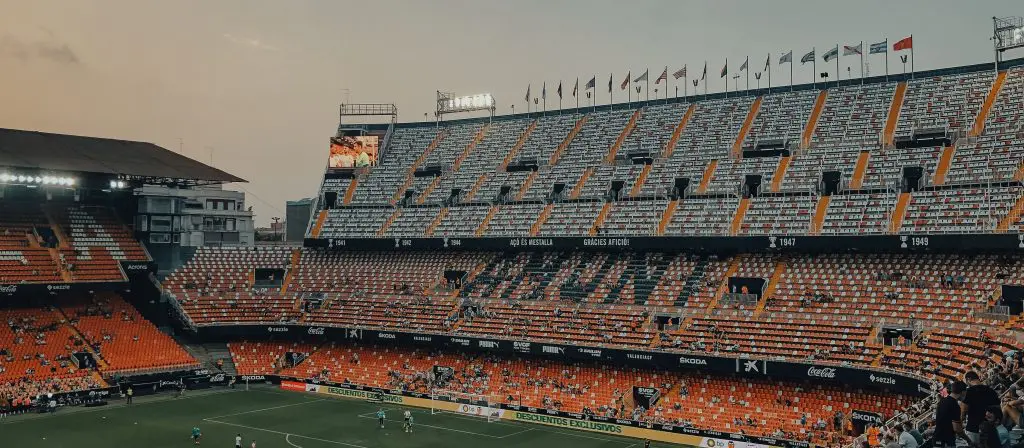
Everything you need to know for your football excursion to Valencia CF
We have compiled some of the best tips for you to ensure you have an unforgettable football trip. From practical information about the Estadio Mestalla to suggestions when it comes to exploring Valencia.
- information about the Estadio Mestalla, route & tips
- information about Valencia CF
- what you can do in Valencia
The Valencia stadium: The Estadio Mestalla
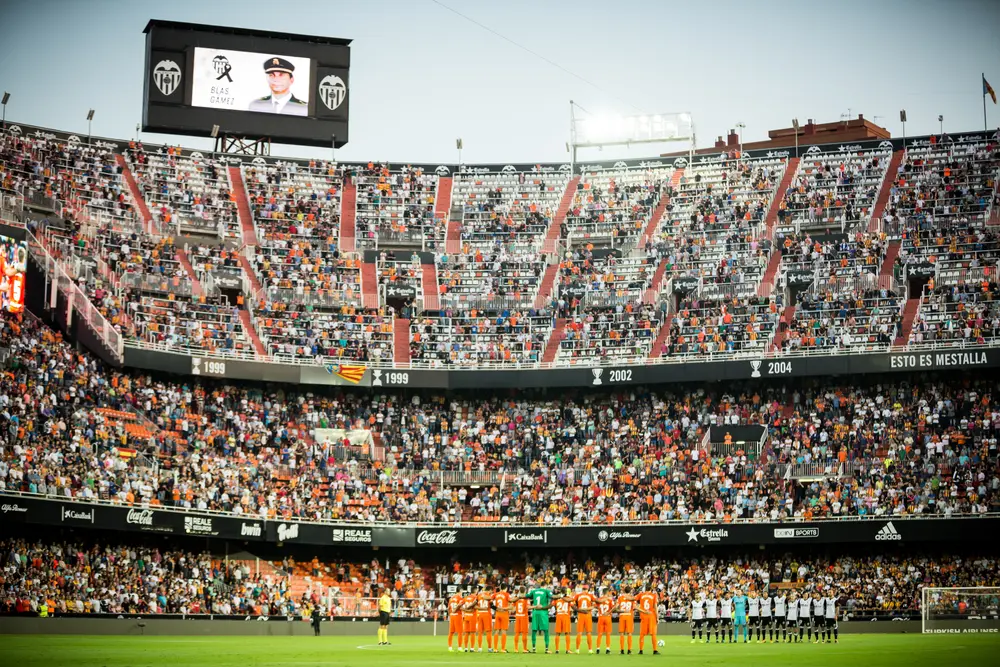
The Mestalla dates back to 1923, making it the oldest stadium in the Primera Division. It opened with the Valencia vs. Levante derby match. Then, the stadium has survived a number of disasters ever since.
The Mestalla was rebuilt for the first time in 1927, and the capacity increased from 17,000 to 25,000. However, the Spanish Civil War broke out in 1936. The stadium was almost entirely destroyed by bombs; only the main stand remained intact. The stadium was completely rebuilt after the war and had a capacity of 45,500 seats. But another disaster followed in 1957, when the Turia River overflowed and caused severe damage. A section of Mestalla collapsed completely.
This disaster was also overcome. A major renovation followed in 1978 with a view to hosting the 1982 World Cup. Spain’s national team played all of its group matches at Valencia’s stadium in the first group stage.
Valencia CF made a decision at the start of this century to leave the stadium, sell the land and to build a new stadium elsewhere. The construction of Nou Mestalla with a capacity of 75,000, got under way in 2007, so that Valencia would be in a position to move in during the summer of 2009. The construction work was put on ice in February 2009 due to major financial issues. No further work has been carried out on the new stadium ever since.
Some money has been spent on refurbishing the old Mestalla over recent years. All of the white seats were replaced and the stadium is now coloured in bright orange following the 90th anniversary of the stadium in 2013. The outside of the stadium was painted in black and orange during the summer of 2014, and was decorated with large photos of former players and its sporting successes.
Currently, the stadium has an all-seated capacity of 52,469. It is especially notorious as a stadium with the steepest stands in world football. The atmosphere is often seriously intimidating. There are plans nevertheless to exchange the stadium for a new home over the next few years.
How do you get to the Mestalla?
Estadio Mestalla is located approximately two kilometres northeast of the city centre. Therefore, it is easily walkable to the stadium. You can walk from the Plaça de la Reina to the Mestalla in twenty minutes.
But you can also get to the stadium easily by using public transport. Valencia has an excellent transport network, with 60 bus lines, five underground lines and four tram lines.
By underground
The underground is the most efficient way to get to the stadium. Take line 5 (the green one) towards Marítim Serrer and alight at the Aragón stop. You can walk to the Estadio Mestalla in three minutes from this stop. You can also take the lines 3 (red) and 7 (orange) to the Alameda metro station, which is approximately 600 metres away from the stadium.
The Estadio Mestalla address details
Avenida de Suècia
46010 Valencia
Spain
By bus
There are several bus lines that stop close to the stadium.
Bus number 10 departs from the Ayuntamiento Square and heads towards to Aragón, which is adjacent to the stadium.
You can walk to Plaza de L’Ajuntement in the city centre, from where bus 32 takes you to the stadium in eight minutes.
Bus lines 25, 79 and 93 also stop close by the stadium.
And you can always get back with night bus N1 if you plan on a late one.
By taxi
You can also travel to the stadium from the city centre by taxi. Taxis are a lot cheaper here. They cost approximately € 1.25 per kilometre on weekends, along with a standing meter charge of € 1.50.
You will spend between € 5 and € 7.50 for a ride to the Mestalla if travelling from the city centre. The drivers are obliged to provide an overview of the rates inside the vehicle. You can just flag down a taxi on the street; and the taxi is available when the green light is on.
Stadium map
The Mestalla has a total of three tiers. The lower tier is incredibly small. The Av. Aragon, Gol Norte and Gol Sur tier all form a horseshoe shape. The Gol Norte and Gol Sur stands have the steepest areas.
The stadium stands are:
- Suecia (The West Stand). This is considered to be the main stand as this is where the dugouts, players’ tunnel and the changing rooms are located. It is the smallest stand which only consists of two tiers. It is also the only stand which is fully covered. This is handy for when it rains in Valencia on the odd occasions. Here you will find areas 111 to 217 (tier 1) and from 311 to 417 (tier 2).
- Aragon (The East Stand). This is the largest stand in the stadium, which is opposite the main stand. You will have a pleasant view of the players tunnel and the dugouts on the other side of the pitch. Here are areas 151 to 257 (tier 1), 351 to 458 (tier 2) and 551 to 753 (tier 3).
- Gol Norte (The North Stand). This section is well known for the steepest seats in Europe. You should not suffer from vertigo if you are seated at the top. Away supporters sit upstairs in the north eastern corner. The areas in this stand are 131 to 233 (tier 1), 331 to 435 (tier 2) and 531 to 733 (tier 3).
- Gol Sur (The South Stand). This is the stand behind the goal on the south side and is almost identical to the Gol Norte, only here the name of the club is depicted with coloured seats. This part of the stadium is where the most fanatical supporters can be found. The areas in this stand are 171 to 273 (tier 1), 371 to 475 (tier 2) and 571 to 774 (tier 3)
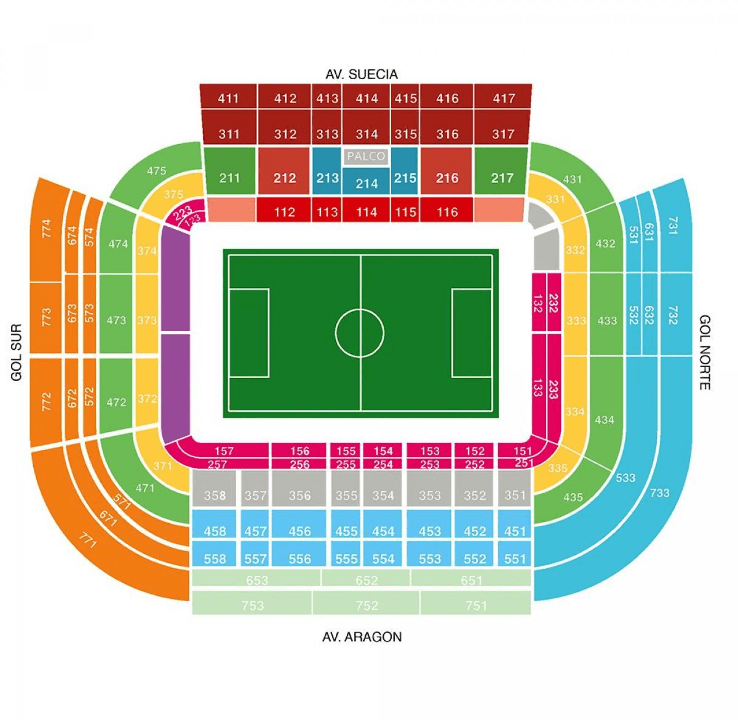
The stadium tour and museums
It is of course also a must to take a look behind the scenes and walk through the players tunnel and onto the pitch whenever you watch a game at the Estadio Mestalla,. Thankfully, it is possible to take a guided tour of the Valencia club museum and stadium several times throughout the day.
The Mestalla Forever Tour
Around five guided tours take place on a daily basis apart from on match days. You will be shown around by a tour guide, who is normally a passionate fan, and who will tell you (in both Spanish and in English) all about the history of the club. You will visit the trophy room, the press area, the dressing room, the chapel where players come to pray for help, the players’ tunnel, dugouts and the pitch. There will be plenty of time to have a look around and take photos. The visit lasts for around one hour. Adults pay € 11,50, children € 9 and children of up to five years of age can be admitted free of charge. It is recommended to book this visit via the club’s website to ensure you have a spot for the tour.
Snacks and drinks in the vicinity of the stadium
The stadium is located in a densely populated area, where there is a wide range of cafes and restaurants. East of the stadium you will find the Plaça del Cedre, which is lined with bars where lots of fans go for a drink. You will find even much more of a choice in the centre of the Plaça de la Reina which is close to the cathedral. You should definitely not rule out the boulevard on the beach for a decent paella. We have compiled a list of some of the best dining options.
The Bar Cerverceria Splash
The ‘Manolo del Bombo’ bar has been a household name among football supporters all over the world for decades. Everyone knew of Manolo, the passionate Valencia supporter who visited ten World Cups along with his mother and was able to talk about them very openly. His bar grew into a genuine football museum. Unfortunately Manolo recently retired, however he was lucky enough to find a buyer who will retain the old features of the bar as much as possible. It is still the place where Valencia fans go for a drink both before and after the game. The bar is located on the Plaza del Valencia Club de Futbol, which is just a stone’s throw away from the Mestalla. You can order a menu or opt for the all inclusive buffet. And you will also come across Manolo if you are lucky; who although retired, can normally be found in the bar on match days!

The Cerveceria Castillo de Quintos
This pub is located approximately 500 metres from the Estadio Mestalla. It is a university district and this is evident from the clientele. Lots of students, very cheap beer, tapas meals and a nice terrace. It is an ideal place to engage in animated conversation with young Spaniards. The atmosphere is both relaxed and friendly. It is a brilliant place to have a drink before or after the game.

Finnegans of Dublin
Finnegans opened in 1995, making it the first Irish pub in the city. The bar quickly became one of the most popular venues in Valencia. The pub is set in an ideal location on Plaça de la Reina, which is close to the cathedral. Matches are shown on a big screen and there is live music almost every night. There is of course plenty of beer and the kitchen provides delicious homemade dishes. Enjoy the Irish theme, an Irish potato or a steak and Guinness pie.

La Paz
Don’t forget to grab a bite to eat on the beautiful boulevard by the beach. You have countless restaurants, and La Paz is clearly one of the better ones. The Paella Valenciana (with chicken and rabbit) in particular is considered by a number of people to be the best in town. The sangria is also highly recommended. Arrive in time for a table with a view of the sea, because it can become packed very quickly when the weather is nice. La Paz is located at the start of the beach at Passeiq de Neptú 42-44. It is open daily from 1 pm to 5 pm and from 8 pm to 11 pm (Sunday evenings only).
Information about Valencia CF
Valencia was founded in the Torino Bar in Valencia back in 1919. It took until 1929 for the club to be promoted to the top flight.
Valencia CF started to become successful after the Spanish Civil War. They won the Copa del Rey in 1941, and were crowned Spanish league champions a year late. The new Mestalla became a real fortress. The club were also crowned Spanish champions in both 1944 and 1946. A few more spasmodic successes followed over the next few decades.
Valencia achieved true international fame in 1980, when they won the UEFA Cup with the prolific Mario Kempes among their ranks, and beat Arsenal on penalties. They also won the European Super Cup the same year. Financial problems however piled up and sent the club into decline. Valencia were even relegated to the second division in 1986.
Valencia was back among the elite by the end of the 1990s. They were Champions League finalists in both 2000 and 2001. The club won the UEFA Cup under Rafael Benitez in 2004. Valencia continued to compete at the top in the Primera División over the next decade, but were unsuccessful in European competitions. The enormous amount of debt has been hanging over the club for the best part of two decades. This meant that Valencia has had to a number of decent players, and often below market value. Selling the land around the Mestalla and the construction of a new stadium means Valencia are hoping to be rid of these problems fairly quickly.
Valencia CF’s main rival is Levante, who play in the same city. The rivalry is very much alive between the sets of supporters, although this club is seen as a little brother and the bond between the two clubs is exceptionally good. The rivalry dates back to the early 20th century, when Valencia were regional champions.
Villarreal CF is also a rival from the same region. Particularly now that this club has become on a level par with Valencia at a sporting level over recent years.
The Valencia CF logo
The Valencia CF logo hasn’t changed a great deal over the years. The emblem is painted by a black bat sitting above a shield. The bat has been a symbol of the city of Valencia for centuries. Some people do believe that this has something to do with the fact that bats are frequently found in the area. A bat landed on the flag of the king of Aragon according to other tales when he wanted to liberate Valencia from the moorlands. It was adopted by the city as an icon shortly thereafter.
Below the bat you can find a shield with the name of the club at the top, and below you can find the flag of the city of Valencia, with a classic football in the centre.
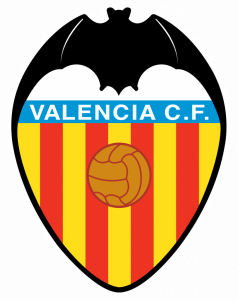

The Valencia CF strip
Valencia played in an all-white strip when it was founded, and which were purchased from English traders who visited to sell fruit. The white shorts were replaced by black ones over the next few years, and it has remained that way ever since. This is just like the away strip, which is almost always orange. This is the colour of the city of Valencia and is symptomatic of the fruit.
What can you do in Valencia ?
Valencia is a fabulous city to visit with 300 days of sunshine a year and an average annual temperature of 18 degrees Celsius. It provides an ideal climate for a pleasant walk along the beach and the boulevard. The city however also has a great deal to offer in terms of culture. We have listed a few attractions that you should definitely not miss out during your trip.
Ciudad de las Artes y las Ciencias
This ‘artistic and scientific city’ consists of seven futuristic micro breweries that house a number of top tourist attractions. This is where you will find largest sea aquarium in Europe, a planetarium, a science museum, an IMAX movie theatre and the pedestrianised promenade with a botanical palm tree garden. You can choose between individual entrance tickets or combined tickets which are discounted.
You can reach the complex by taking underground line 5. It is then a 10-15 minute walk away if you alight at Alameda. The hop-on-hop-off bus stops right outside.
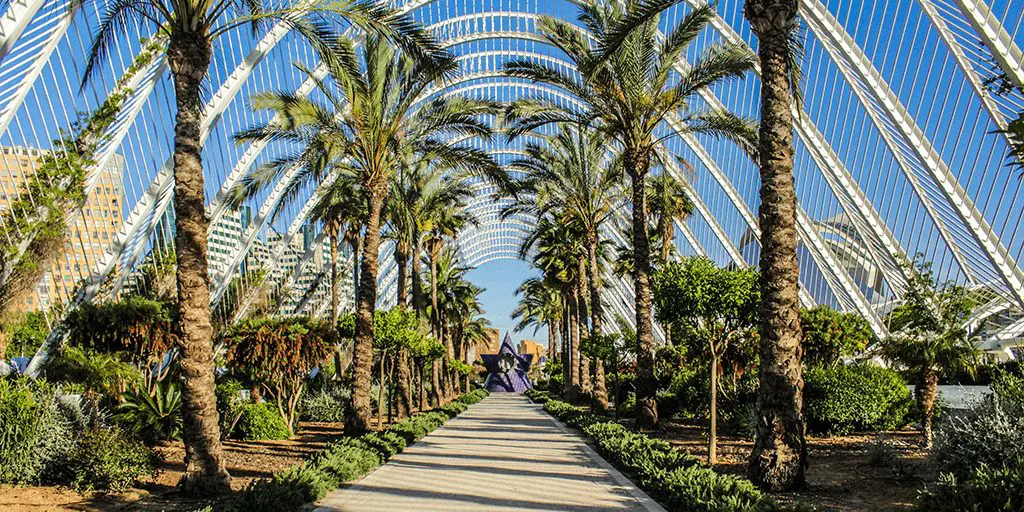
Mercado Central
This impressive building, which occupies more than 8,000 square meters, is home to the largest fresh produce market in Europe. The locals stock their fresh vegetables, fruit, fish and spices on over 400 stalls. The hall itself was built in 1928, and is also a jewel in the crown, with a thirty meter high crystal dome to attract people’s attention. The market is open from Monday to Saturday from 7:30 pm to 3pm and is easily accessible by using the underground (via the Angel Guimera stop).
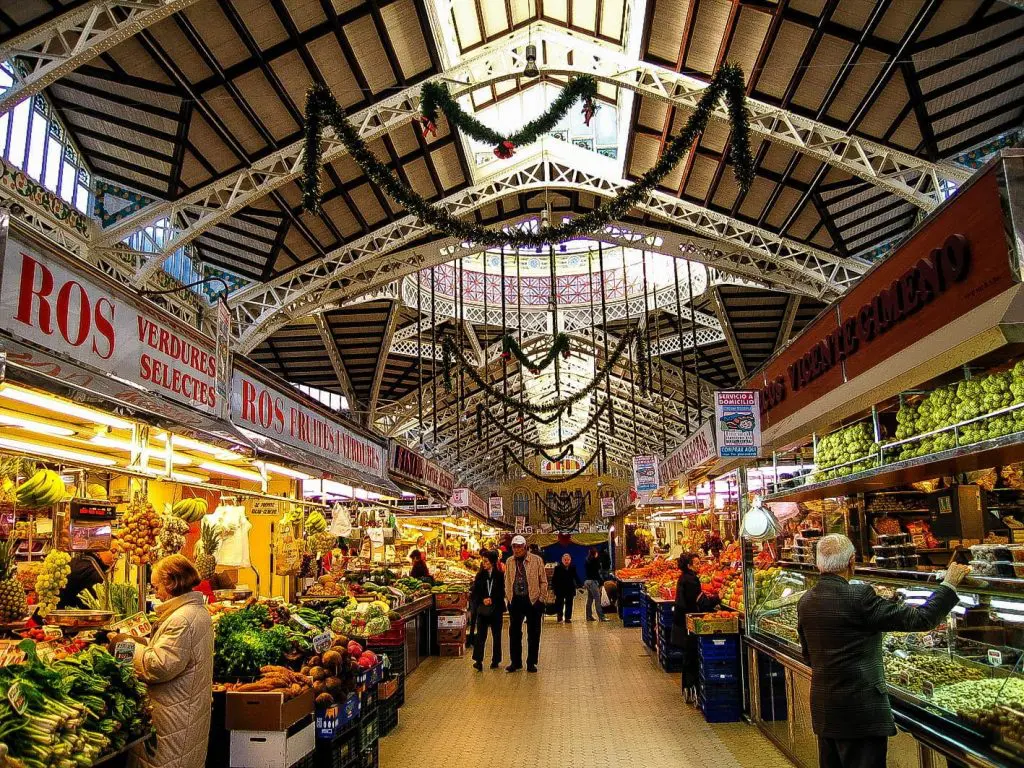
The Valencia Cathedral
This cathedral was built in between 1262 and 1356 and combines various architectural styles, including Romanesque, Baroque and Gothic. The cathedral museum has a large number of unique artistic treasure. There are various paintings by Goya which people can admire, however the showpiece is the ‘Holy Grail’. It is alleged that Jesus is said to have drunk at the Last Supper from this stone. There is a beautiful bell tower next to the cathedral. You will have the best view over the old city having climbed the 207 steps. The cathedral is open from Monday to Saturday from 10am to 6:30pm, and from 2pm to 6:30pm on Sundays. Admission costs €8. You will have to pay €2 to climb the tower. The cathedral is about a five minute walk from the Colón and Xativa underground stops. Bus lines 4.9, 19, 80, 81, 94 and C1 also stop close to the cathedral.
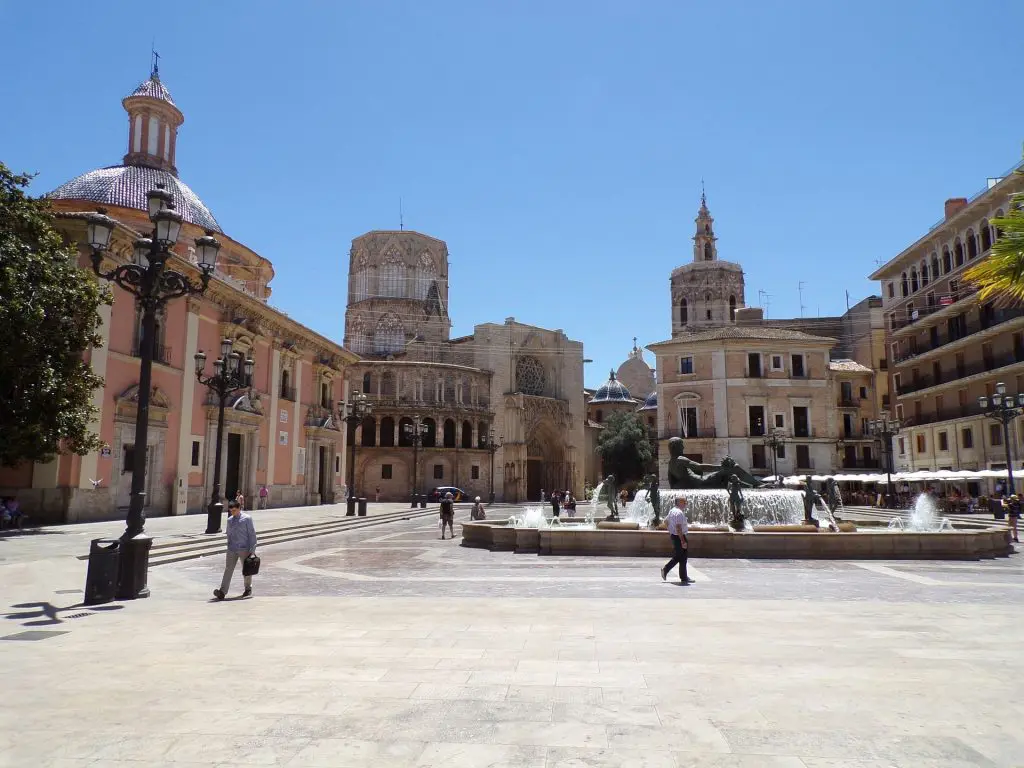
The beaches
There are several beautiful beaches in and around Valencia where many people visit for a beach holiday. You can find the incredible Las Arenas beach close to the city centre.
The 1.2 kilometre long beach has a clean and vibrant promenade with numerous restaurants and bars. Take the tram from Pont de Fusta to get to this beach. You can alight after 15 minutes at the Les Arenas stop, and you are immediately on the seafront. You can also take bus 19 from Plaza de Ayuntamiento.
